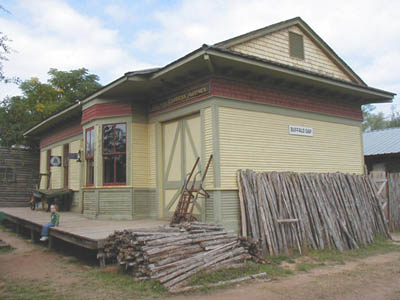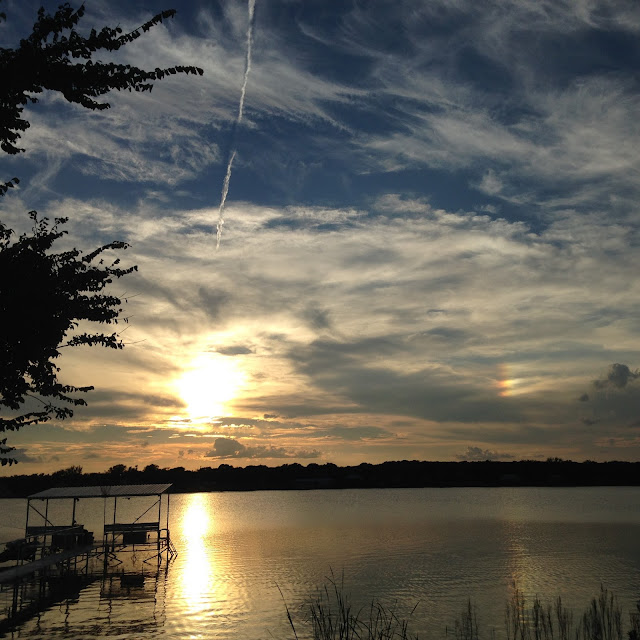Buffalo Gap Derailment
 |
| The old Texas & Pacific depot in Buffalo Gap |
In early 1973 I was Foreman of the Sweetwater Section Gang, Santa Fe Railroad. We had just finished a hard day's work in Lawn, Texas and were heading back to Sweetwater when we received a call on the radio from the Train Dispatcher. He had bad, mood changing news. There had just been a bad train derailment at Buffalo Gap. We were to head that way immediately and give any assistance needed.
We were the first to reach the derailment site. We determined that the train crew was ok and that there was no hazardous material involved. There were twenty-five or thirty rail cars piled up in a relatively short space looking like Pick-Up-Stix. There was about a half a mile of main track either destroyed or heavily damaged as well as the siding track. This was going to be a long, long process.
By dark the work train had arrived at the site carrying the derrick crane, rail and crossties, ballast rock and most important, the derrick diner car. That first night and well into the next day the mechanical forces cleared the maze of derailed rail cars from the site by either picking them up with the derrick crane or shoving and pulling them out of the way with huge dozers.
My gang and I spent all night running back and forth to Sweetwater and Brownwood gathering additional track material that would be needed once the mechanical forces had cleared enough track for us to begin rebuilding the main track. It was determined that the siding would have to wait for another time. For now all hands would work on getting train traffic moving on the main track.
We had just pulled back up to the derailment site as the sun begin to peek over the somewhat smaller pile of wrecked rail cars. As we dismounted the section truck the smell of bacon, eggs and coffee drifted heavily over the site. The cook, usually one of the older Mechanical Department men, began to ring the diner car bell which was an indication that he was ready to start the feeding process as time would permit. As we walked toward the site, the Roadmaster hollered at me to go ahead and take my men to the diner before we started rebuilding the railroad.
For the next thirty or forty minutes there wasn't a place on earth that we would have rather been. The old cook normally wasn't much to look at but today deserved a big 'ole' hug. Eggs, ham, bacon, pancakes, biscuits, sausage, milk, coffee and orange juice for all. As we ate, the old cook was busy preparing grub for lunch. It was apparent that, while we may get tired and need rest, if the cook had anything to do with it, we weren't going to be hungry.
As the day wore on time began to take a toll as fatigue crept in. We began to take shifts going back to the truck and taking an hour or two nap. So went the night. By the next morning, the third day, we were finally laying the last rail and driving the last spikes as we connected up the main track. All that was left was to unload the ballast rock from the work train onto the track, jack the track up on top of the rock, and unload rock one final time. With fatigue being the biggest factor this was going to be a tough few hours.
To unload ballast rock it is necessary to walk alongside the train as it slowly moves at one or two MPH and operate the hopper doors with long heavy wrenches letting the rock roll from the car onto the bare ties. Once started you can't stop because the rock would pile up on the track and derail the car. As the rock rolled from the car, dust would rise up and stick to your sweaty face and arms and make visibility and breathing tough.
We had finished the first unloading, jacked and lined the track and were ready to start the final unloading of ballast rock. The Roadmaster checked to see that we were all ready then turned toward the engines and gave a hand signal to move the train ahead slowly. The train didn't move. He again gave the 'move ahead' signal and again the train didn't move. We looked toward the engines, about fifteen or so car lengths away, and we could see the Engineer dismounting the locomotive and slowly walking toward us. The Roadmaster grumbled," What the hell is wrong with that engineer."
We all sat down on the edge of the track as we waited for the short stocky engineer to waddle down to our location. When he finally reached our location, he removed his hat, wiped the sweat from his brow and said, "Say boss, I got to go home. My wife thinks she can't go into the bathroom and crap unless I'm there brushing my teeth and I haven't been home in three days. Poor woman is in trouble." With that said, he simply put his hat back on, turned and began his long walk back to the engine.
We all sat down on the edge of the track as we waited for the short stocky engineer to waddle down to our location. When he finally reached our location, he removed his hat, wiped the sweat from his brow and said, "Say boss, I got to go home. My wife thinks she can't go into the bathroom and crap unless I'm there brushing my teeth and I haven't been home in three days. Poor woman is in trouble." With that said, he simply put his hat back on, turned and began his long walk back to the engine.
The Roadmaster watched him walk a couple of car lengths and then turned toward us with a frown that melted away into a grin and finally into a full hardy laugh as did we all. We all sat there in the shade of the train laughing and for a while forgot about the aching dominance of the fatigue that had long possessed our bodies. The old engineer finally got back to his engine and sounded two long blasts on his whistle which indicated he was ready to move ahead. We had a much needed break, as much mentally as physically, and with the sounding of the whistle, we stood and continued our trek toward completion of our formidable task.
 |
| Most Divisions on the Old Santa Fe had a derrick crane, a dinner car and material cars that would be placed in a work train and taken to major derailments. |


Comments
Post a Comment